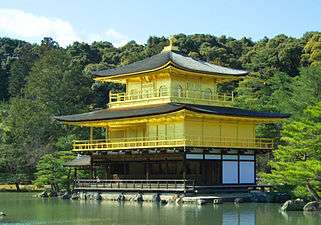Ashikaga Yoshimitsu
| Ashikaga Yoshimitsu 足利 義満 | |
|---|---|
 | |
| Shōgun | |
|
In office 1368–1394 | |
| Monarch | |
| Preceded by | Ashikaga Yoshiakira |
| Succeeded by | Ashikaga Yoshimochi |
| Personal details | |
| Born | September 25, 1358 |
| Died | May 31, 1408 (aged 49) |
| Spouse(s) |
Among others... |
| Children |
Among others... |
| Parents |
|

Ashikaga Yoshimitsu (足利 義満, September 25, 1358 – May 31, 1408) was the 3rd shōgun of the Ashikaga shogunate, which was in power from 1368 to 1394 during the Muromachi period of Japan. Yoshimitsu was Ashikaga Yoshiakira's third son but the oldest son to survive, his childhood name being Haruō (春王). Yoshimitsu was appointed shōgun, a hereditary title as head of the military estate, in 1368 at the age of ten; at twenty he was admitted to the imperial court as Acting Grand Counselor (Gon Dainagon 権大納言). In 1379, Yoshimitsu reorganized the institutional framework of the Gozan Zen 五山禅 establishment before, two years later, becoming the first person of the warrior class to host a reigning emperor at his private residence. In 1392, he negotiated the end of the Nanboku-chō imperial schism that had plagued politics for over half a century. Two years later he became Grand Chancellor of State (Dajō daijin 太政大臣), the highest-ranking member of the imperial court. Retiring from that and all public offices in 1395, Yoshimitsu took the tonsure and moved into his Kitayama-dono (北山殿) retirement villa which, among other things, boasted a pavilion two-thirds covered in gold leaf (Kinkaku shariden 金閣舎利殿). There, he received envoys from the Ming and Joseon courts on at least six occasions and forged the terms of a Sino-Japanese trade agreement that endured for over a century. In recognition for his diplomatic efforts (and overt displays of subservience), the Chinese sovereign pronounced Yoshimitsu "King of Japan" (Nihon kokuō 日本国王). In 1407, he set into motion a plan to become "Dajō tenno" (太上天皇), a title customarily applied to a retired emperor. Although unrealized due to his sudden death the following year, this last venture was particularly audacious because Yoshimitsu never actually sat on the Japanese throne.[1] Late in his career, it appears Yoshimitsu sought to legitimize his transcendent authority through the idiom of Buddhist kingship, deploying ritual, symbols, and monumentalism to cast him as a universal monarch or dharma king, not unlike his counterparts in Southeast Asia.[2] His posthumous name was Rokuon'in (鹿苑院).
Timeline
Significant events shape the period during which Yoshimitsu was shōgun:
- 1368 – Yoshimitsu appointed shōgun;[3] Chōkei ascends southern throne.[4]
- 1369 – Kusunoki Masanori defects to Ashikaga.[4]
- 1370 – Imagawa Sadayo sent to subdue Kyushu.[4]
- 1371 – Attempts to arrange truce.[4]
- 1373–1406 – Embassies between China and Japan.[4]
- 1374 – En'yū ascends northern throne.[4]
- 1378 – Yoshimitsu builds the Muromachi palace in Kyoto's elite district of Kamigyo, on the site of the former residence of the nobleman Saionji Sanekane.[5]
- 1379 – Shiba Yoshimasa becomes Kanrei.[4]
- 1380 – Kusunoki Masanori rejoins Kameyama; southern army suffers reverses.[4]
- 1382 – Go-Komatsu ascends northern throne; resurgence of southern army.[4]
- 1383 – Yoshimitsu's honors; Go-Kameyama ascends southern throne.[4]
- 1385 – Southern army defeated at Koga.[4]
- 1387–1389 – Dissension in Toki family in Mino.[4]
- 1389 – Yoshimitsu pacifies Kyūshū and distributes lands; Yoshimitsu opposed by Kamakura kanrei Ashikaga Ujimitsu.[4]
- 1390 – Kusunoki defeated; Yamana Ujikiyo chastises Tokinaga.[4]
- 1391 – Yamana Ujikyo attacks Kyoto – Meitoku War.[6]
- 1392 – Northern and Southern courts reconciled under Go-Komatsu.[6]
- 1394 – Yoshimitsu officially cedes his position to his son;[7] Ashikaga Yoshimochi appointed shōgun.[6]
- 1396 – Imagawa Sadayo dismissed.[6]
- 1397 – Uprising in Kyūshū suppressed.[6]
- 1398 – Muromachi administration organized.[6]
- 1399 – Ōuchi Yoshihiro and Ashikaga Mitsukane rebel – Ōei War.[6]
- 1402 – Uprising in Mutsu suppressed.[6]
- 1404 – Yoshimitsu is recognized as Nippon Koku-Ō (King of Japan) by Emperor of China.
- 1408 – Yoshimitsu dies.[6]
Muromachi
Yoshimitsu constructed his residential headquarters along Muromachi Road in the northern part of Kyoto in 1378. As a result, in Japanese, the Ashikaga shogunate and the corresponding time period are often referred to as the Muromachi shogunate and Muromachi period.[8]
Yoshimitsu resolved the rift between the Northern and Southern Courts in 1392, when he persuaded Go-Kameyama of the Southern Court to hand over the Imperial Regalia to Emperor Go-Komatsu of the Northern Court. Yoshimitsu's greatest political achievement was that he managed to bring about the end to Nanboku-chō fighting. This event had the effect of firmly establishing the authority of the Muromachi shogunate and suppressing the power of the regional age daimyōs who might challenge that central authority.[9]
Concordant with increased communication between the Muromachi Shogunate and the Ming Dynasty in modern day China, during this period Japan received a significant influx of Ming influence to its economic system, architecture, philosophy and religion, and writing. [10]
Although Yoshimitsu retired in 1394 and his son was confirmed as the fourth shōgun Ashikaga Yoshimochi, the old shōgun did not abandon any of his powers. Yoshimitsu continued to maintain authority over the shogunate until his death.[11]
Yoshimitsu also played a major role in the genesis of Noh theatre, as the patron of Zeami Motokiyo, the actor considered to be Noh's founder.
Yoshimitsu died suddenly in 1408[11] at age 50.[12] After his death, his retirement villa (near Kyoto) became Rokuon-ji, which today is famous for its three-storied, gold-leaf covered reliquary known as "Kinkaku". So famous is this single structure, in fact, that the entire temple itself is often identified as the Kinkaku-ji, the Temple of the Golden Pavilion. A statue of Yoshimitsu is found there today.[13]
Family
- Father: Ashikaga Yoshiakira
- Mother: Kino Yoshiko (1336–1413) (among others)
- Wife: Hino Nariko (1351–1405)
- Concubines:
- Ichijo no Tsubone
- Hino Yasuko (1369–1419)
- Fujiwara no Yoshiko (1358–1399)
- Kaga no Tsubone (d. 1422)
- Kasuga no Tsubone
- Nefu'in (1370–1421)
- Fujiwara no Kyoko (1369–1406)
- Fujiwara no Tomoko (d. 1426)
- Keijun'in
- Takahashi-dono (d. 1429)
- Ikegami-dono (d. 1426)
- Children:
- a daughter by Nariko
- Ashikaga Yoshimochi by Yoshiko
- Ashikaga Yoshinori by Yoshiko
- Ashikaga Yoshitsugu (1394–1418) by Kasuga
- Daijiin Seishou (1395–1433) by Nefu'in
- Gisho (1406–1467) by Tomoko
- Irie Juzen (1397–1415) by Yoshiko
- Sonman by Kaga
- Hodo (1385–1387) by Kaga
- a boy (1394–1436) by Kyoko
- Daijin'in Sei (1396–1453) by Kyoko
- a daughter married Rokkaku Mitsutsuna
- Kaji Yoshiaki (1406–1467) by Tomoko
- Koshoin by Keijun'in
- a daughter by Ikegami
- Kozan Eiryu (1403–1442) by Ikegami
Eras of Yoshimitsu's bakufu
The years in which Yoshimitsu was shōgun are more specifically identified by more than one era name or nengō.[14] Nanboku-chō southern court
- Eras as reckoned by legitimate Court (as determined by Meiji rescript):
Nanboku-chō northern court
- Eras as reckoned by pretender Court (as determined by Meiji rescript):
Post-Nanboku-chō reunified court
Notes
- ↑ Stavros, Matthew, and Norika Kurioka. "Imperial Progress to the Muromachi Palace, 1381 A Study and Annotated Translation of Sakayuku Hana". Japan Review 28 (2015): 3–46. https://www.jstor.org/stable/43684115
- ↑ Stavros, Matthew (December 2017). "Monuments and Mandalas in Medieval Kyoto: Reading Buddhist Kingship in the Urban Plan of Ashikaga Yoshimitsu". Harvard Journal of Asiatic Studies. 77: 321–361 – via Project Muse.
- ↑ Sansom, George (1961). A History of Japan, 1334-1615. Stanford University Press. pp. 108–109. ISBN 0804705259.
- 1 2 3 4 5 6 7 8 9 10 11 12 13 14 Ackroyd, Joyce. (1982) Lessons from History: The "Tokushi Yoron", p. 329.
- ↑ Stavros, Matthew. (2009) "Locational Pedigree and Warrior Status in Medieval Kyoto: The Residences of Ashikaga Yoshimitsu", in Japanese Studies (vol. 29, no. 1, May) p. 8.
- 1 2 3 4 5 6 7 8 9 Ackroyd, p. 330.
- ↑ Titsingh, p. 321., p. 321, at Google Books
- ↑ Morton, W. Scott et al. (2004). Japan: Its History and Culture, p. 89., p. 89, at Google Books
- ↑ Turnbull, Stephen. (2005). Samurai Commanders, p. 31., p. 31, at Google Books
- ↑ "日本の中国観 ― 中世・近世 ― : 日中比較文化学の視点".
- 1 2 Titsingh, p. 325., p. 325, at Google Books
- ↑ Turnbull, p. 32.
- ↑ Pier, Garrett. (1915). Temple Treasures of Japan, pp. 228–237., p. 228, at Google Books
- ↑ Titsingh, pp. 308–321., p. 308, at Google Books
References
- Ackroyd, Joyce I. (1982) Lessons from History: the Tokushi Yoron. Brisbane: University of Queensland Press. ISBN 9780702214851; OCLC 7574544
- Morton, W. Scott and J. Kenneth Olenik. (1973). Japan: Its History and Culture. Newton Abbot, Devon: David & Charles. ISBN 9780715357682; OCLC 462186835
- Pier, Garrett Chatfield. (1914). Temple Treasures of Japan. New York: Frederick Fairchild Sherman. OCLC 535337
- Stavros, Matthew, and Norika Kurioka. "Imperial Progress to the Muromachi Palace, 1381 A Study and Annotated Translation of Sakayuku Hana". Japan Review 28 (2015): 3–46. https://www.jstor.org/stable/43684115
- Stavros, Matthew (December 2017). "Monuments and Mandalas in Medieval Kyoto: Reading Buddhist Kingship in the Urban Plan of Ashikaga Yoshimitsu". Harvard Journal of Asiatic Studies. 77: 321–361
- Titsingh, Isaac. (1834). Nihon Ōdai Ichiran; ou, Annales des empereurs du Japon. Paris: Royal Asiatic Society, Oriental Translation Fund of Great Britain and Ireland. OCLC 585069
- Turnbull, Stephen. (2005). Samurai Commanders. Oxford: Osprey Press. ISBN 9781841767437; ISBN 9781841767444; OCLC 60834971
- Worden, Robert L. (1994). "Kamakura and Muromachi Periods, 1185–1573; Economic and Cultural Developments", A Country Study: Japan. Washington, D.C.: Federal Research Division, Library of Congress.
External links
| Wikimedia Commons has media related to Ashikaga Yoshimitsu. |
| Preceded by Ashikaga Yoshiakira |
Shōgun: Ashikaga Yoshimitsu 1368–1394 |
Succeeded by Ashikaga Yoshimochi |
